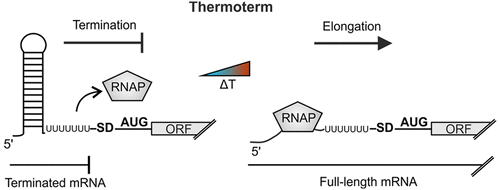当前位置:
X-MOL 学术
›
ACS Synth. Biol.
›
论文详情
Our official English website, www.x-mol.net, welcomes your
feedback! (Note: you will need to create a separate account there.)
Design of a Temperature-Responsive Transcription Terminator
ACS Synthetic Biology ( IF 3.7 ) Pub Date : 2017-12-12 00:00:00 , DOI: 10.1021/acssynbio.7b00356 Johanna Roßmanith 1 , Mareen Weskamp 1 , Franz Narberhaus 1
ACS Synthetic Biology ( IF 3.7 ) Pub Date : 2017-12-12 00:00:00 , DOI: 10.1021/acssynbio.7b00356 Johanna Roßmanith 1 , Mareen Weskamp 1 , Franz Narberhaus 1
Affiliation

|
RNA structures regulate various steps in gene expression. Transcription in bacteria is typically terminated by stable hairpin structures. Translation initiation can be modulated by metabolite- or temperature-sensitive RNA structures, called riboswitches or RNA thermometers (RNATs), respectively. RNATs control translation initiation by occlusion of the ribosome binding site at low temperatures. Increasing temperatures destabilize the RNA structure and facilitate ribosome access. In this study, we exploited temperature-responsive RNAT structures to design regulatory elements that control transcription termination instead of translation initiation in Escherichia coli. In order to mimic the structure of factor-independent intrinsic terminators, naturally occurring RNAT hairpins were genetically engineered to be followed by a U-stretch. Functional temperature-responsive terminators (thermoterms) prevented mRNA synthesis at low temperatures but resumed transcription after a temperature upshift. The successful design of temperature-controlled terminators highlights the potential of RNA structures as versatile gene expression control elements.
中文翻译:

温度响应转录终止子的设计
RNA结构调节基因表达的各个步骤。细菌中的转录通常由稳定的发夹结构终止。可以通过对代谢物或温度敏感的RNA结构(分别称为核糖开关或RNA温度计(RNAT))来调节翻译起始。RNAT通过在低温下封闭核糖体结合位点来控制翻译起始。温度升高会破坏RNA结构的稳定性并促进核糖体的进入。在这项研究中,我们利用温度响应性RNAT结构来设计调控元件,该元件控制大肠杆菌中的转录终止而不是翻译起始。为了模拟独立于因子的内源性终止子的结构,对天然存在的RNAT发夹进行了基因工程改造,然后进行了U型拉伸。功能性温度响应性终止子(温度)在低温下阻止了mRNA的合成,但在温度升高后恢复了转录。温度控制终止子的成功设计突显了RNA结构作为通用基因表达控制元件的潜力。
更新日期:2017-12-12
中文翻译:

温度响应转录终止子的设计
RNA结构调节基因表达的各个步骤。细菌中的转录通常由稳定的发夹结构终止。可以通过对代谢物或温度敏感的RNA结构(分别称为核糖开关或RNA温度计(RNAT))来调节翻译起始。RNAT通过在低温下封闭核糖体结合位点来控制翻译起始。温度升高会破坏RNA结构的稳定性并促进核糖体的进入。在这项研究中,我们利用温度响应性RNAT结构来设计调控元件,该元件控制大肠杆菌中的转录终止而不是翻译起始。为了模拟独立于因子的内源性终止子的结构,对天然存在的RNAT发夹进行了基因工程改造,然后进行了U型拉伸。功能性温度响应性终止子(温度)在低温下阻止了mRNA的合成,但在温度升高后恢复了转录。温度控制终止子的成功设计突显了RNA结构作为通用基因表达控制元件的潜力。











































 京公网安备 11010802027423号
京公网安备 11010802027423号